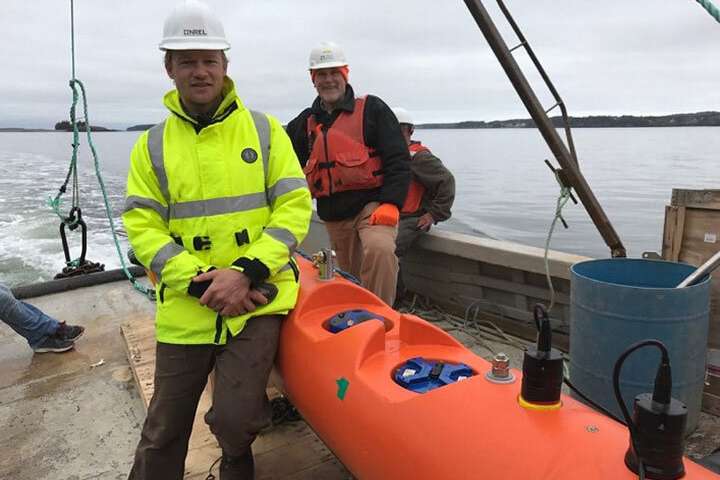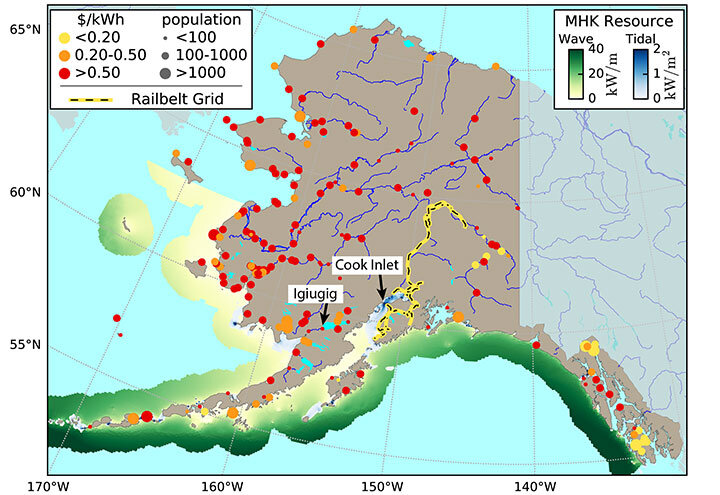The nation's largest yet least densely populated state, Alaska is a land of superlatives and contradictions. For centuries, its remote communities, rugged terrain, extreme weather, natural wonders, and abundant wildlife have sparked the imaginations of intrepid explorers from around the world.
 Levi Kilcher and Bob Lewis prepare to launch the StableWing ocean-turbulence measurement platform in the Western Passage of Maine.
Levi Kilcher and Bob Lewis prepare to launch the StableWing ocean-turbulence measurement platform in the Western Passage of Maine.
Expedition leaders in days gone by hitched huskies to their sleds to traverse the frozen terrain. Now, a new type of pioneer is harnessing a much different type of power—from oceans and rivers—to bring reliable clean energy to far-flung communities across Alaska and beyond.
National Renewable Energy Laboratory (NREL) researchers are working with industry, tribal, government, and national laboratory partners to more effectively harness Alaska's vast marine energy resources. NREL-led assessments are helping the remote tribal village of Igiugig identify self-sustaining microgrid options, while the team's resource characterization work in Cook Inlet has the potential to deliver power to the grid for distribution across the state. The NREL study Marine Hydrokinetic Energy Site Identification and Ranking helped identify sites for these projects.
Although those appear to be two very different undertakings, both require high-quality data and sophisticated modeling for marine energy device and project developers to succeed.
"That's where we step in," said NREL Senior Scientist Levi Kilcher, who is helming both of the projects and grew up on Cook Inlet's shoreline. "Our assessments inform the development of more reliable and affordable marine energy technologies. We're helping identify short-term solutions that meet the needs of Alaska's rural communities, and we're delivering public data needed to design the large-scale marine energy projects of the future."
Tapping the Nation's Greatest Tidal Power Resources
More than 30% of U.S. tidal power can be found in Cook Inlet, which covers approximately 180 miles of south-central Alaska. This offers enough energy to power 18 million homes—well beyond the number of houses in the entire state. Extending to Anchorage, the inlet offers immediate proximity to the state's largest population centers, as well as to the "Railbelt" power grid, which covers 65% of the Alaska population.
At the same time, the very landscape of the area poses challenges. The rivers that flow into Cook Inlet are fed by glaciers and present unique risks to marine power technology. Glacial sediments in Cook Inlet waters can wear on the seals and bearings of tidal turbines, turbulence at the most promising tidal sites is so energetic that its shaking motion could damage the turbines, and submerged icebergs laden with gravel and sand could collide with and damage turbines. NREL's data on turbulence and submerged icebergs is providing developers with the information needed to design devices and systems robust enough to last for decades.
NREL's state-of-the-art resource measurement methods, paired with high-resolution resource modeling at collaborating Pacific Northwest National Laboratory (PNNL) and Sandia National Laboratories, are helping reveal exactly where marine energy projects could prove most viable. Resolution of new wave models is 10 times greater than that of previous models, providing a level of fidelity that makes it possible to accurately identify areas with the greatest potential, as well as possible challenges.
"The characterization and modeling work we're doing lays the groundwork for industry to design and develop systems capable of efficiently extracting marine energy resources and delivering power these communities—and the nation—need," Kilcher said.
 Rural Alaskan energy prices (red, orange, yellow dots) and marine energy resources (green, blue). Credit: Levi Kilcher, NREL
Rural Alaskan energy prices (red, orange, yellow dots) and marine energy resources (green, blue). Credit: Levi Kilcher, NREL
NREL is partnering with PNNL, Ocean Renewable Power Company (ORPC), and Terrasond Limited on the Department of Energy (DOE)-funded Cook Inlet project, building on earlier tidal studies conducted by these partners and the University of Washington in Washington State's Puget Sound and the Western Passage of Maine. In related work by NREL and its partners, researchers plan for wave models to eventually cover the entire U.S. Exclusive Economic Zone in the territorial waters surrounding the United States. Data from these models are being made available online via NREL's Marine and Hydrokinetic (MHK) Atlas.
Developing a Microgrid in a Remote Tribal Village
The 69 residents of Igiugig live more than 40 miles from the next village in southwestern Alaska. This Yup'ik tribal community is not connected to the electrical grid and currently relies on a collection of diesel generators as its primary power source.
NREL is working with the Igiugig Village Council (IVC), the State of Alaska, and other local partners on this DOE-sponsored project to explore the potential for a renewable energy microgrid to provide greater self-sufficiency and a lighter environmental footprint, while serving as a testbed for technologies and honoring cultural values. The team is examining opportunities and challenges for high-penetration renewable energy generation scenarios, collecting data to better understand energy loads, and helping identify a vision for the next 10 to 20 years.
The nearby Kvichak River presents a unique energy resource, steadier and more reliable than ocean marine, wind, or solar sources. In a separate yet related project, NREL is supporting the IVC and ORPC in system validation of a turbine that is planned for deployment in Igiugig. After confirming system and component compatibility and evaluating the microgrid configuration, the team hopes to establish the first long-term system of its kind in this location.
While the river has the potential to provide reliable baseload power, its connection to the Bristol Bay Salmon Run—the largest wild sockeye salmon run in the world—means that the community is intent on making sure that the fish stay clear of the turbine. Previous investigations have demonstrated that fish can safely co-exist with marine installations.
The community is considering a range of energy options, including building energy efficiency measures and wind, solar photovoltaic, solar thermal, and biomass boilers. Preliminary investigations by researchers at NREL and the University of Alaska Fairbanks suggest that a diverse mix of renewable energy sources could provide as much 70% of Igiugig's energy needs without large increases in their energy prices.
The microgrid project grew out of the 2018 Alaska National Lab Day Summit, which brought together leaders from the state of Alaska, DOE, and NREL to better understand how the government can more effectively mobilize research to help communities in rural Alaska. If these projects are successful, the methodologies and technologies could be valuable to other rural communities around the world.
Looking Forward, While Learning from the Past
Motivated in large part by earlier groundbreaking successes in characterization of turbulence to improve wind turbine design, NREL oceanographers, engineers, and data scientists are measuring resource details vital to engineering and designing the next generation of marine energy devices. Kilcher's team is applying lessons from these previous breakthroughs to their activities in Cook Inlet, Igiugig, and beyond.
"Renewable energy is the future, and Alaska's vast marine resources have the potential to play a huge role there," Kilcher said. "It's amazing to be involved in laying the groundwork for clean, reliable energy projects—and the jobs that go with them—in my home state."